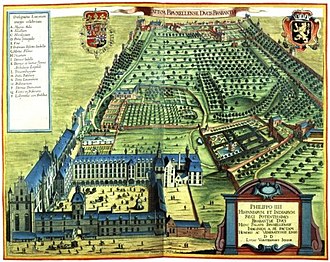Coudenberg
Coudenberg (also: Koudenberg ; Old Dutch: kalter Hügel) is a small hill in Brussels , on which the palace of Coudenberg was located.
For around 700 years the castle and later the Palace of Coudenberg was the seat of counts, dukes, archdukes, kings, emperors and rulers who ruled over the Duchy of Brabant from the 12th to the destruction of the palace in the 18th century .
Today the archaeological foundations of the palace can be visited.
history
Around 1100 the Counts of Leuven built a fortress on the Coudenberg hill from which they ruled Brussels. Brussels and Coudenberg Castle gained importance in the course of the establishment of the Duchy of Brabant. During the construction of the first fortifications of Brussels, the castle was enclosed by them and from then on also served to defend the city.
Despite these fortifications, Count Ludwig II managed to capture the city in 1356 . In 1365 Everard 't Serclaes made a successful attempt at liberation. Under the leadership of Dukes Johanna and Wenceslaus I , the second city wall of Brussels was erected, which also includes the surrounding fields and buildings. The castle, which was now some distance from the new city wall, lost its defensive function and increasingly turned into a residential palace.
In 1430 the Duchy of Brabant was occupied by the House of Burgundy . Philip III had the palace expanded, the park beautified and the Aula Magna built. In 1465 the States General were convened for the first time in the Aula Magna . In the same room Charles V was declared of age in 1515 and around 40 years later he renounced the Spanish throne in the same place in favor of his son Philip II .
During his reign, Charles V had the place des Bailles set up in front of the palace, as well as galleries and rooms in the Renaissance style . He also built the Grand chapelle (Great Chapel) in memory of his parents in Gothic style. The vault of the Order of the Golden Fleece was kept in the chapel .
In the 17th century during the time of the Spanish Netherlands , the palace was further expanded. The Archdukes Albrecht VII of Austria and Isabella Clara Eugenia of Spain restored the showpieces of the palace, the buildings and living rooms as well as the gardens. Numerous well-known artists took part in this work, such as Jan Brueghel the Elder and Peter Paul Rubens .
During the time of the Austrian Netherlands , the palace was inhabited by Maria Elisabeth of Austria . On the night of February 3rd to 4th, 1731 a fire broke out and she was only lucky to save herself. The fire extinguishing work was made difficult by a lack of water and the palace was almost completely destroyed by the fire. There was not enough money for reconstruction. It was not until 1774 that Charles Alexander of Lorraine built the Royal Square instead of the palace and the Royal Park of Brussels , also called Warandepark , instead of the gardens . The few parts of the building that had survived the devastating fire of 1731 to some extent were finally also demolished after 1775. These were essentially the Aula Magna and the court chapel. The cause of the demolition was that the architectural style no longer corresponded to the taste of the time. Only the underground rooms of the castle were preserved and some of them subsequently served as cellars for the new buildings erected above. The old church of St. Jakob on the Koudenberg was replaced by a monastery church designed in neo-classical style ( Sint-Jacob op de Koudenberg / Saint-Jacques-sur-Coudenberg ). The church can still be visited today on Koningsplein.
Archaeological excavations
In the course of the destruction of the ruins, parts of the former palace were reused for the construction of the new buildings - for example as foundations and cellars.
From 1985 to 1987 the first archaeological excavations took place under the direction of the Flemish Community . Further excavations followed from 1995 to 2000 under the direction of the Société royale d'Archéologie de Bruxelles. These excavations can be visited. The archaeological site has been awarded the European Heritage Label .
See also
literature
in alphabetical order
- V. Heymans (dir.), L. Cnockaert & F. Honoré (coord.): Le palais du Coudenberg à Bruxelles. You chateau médiéval au site archéologique . Mardaga, Brussels 2014 (there is also an English and Flemish version)
- Krista De Jonge: Het paleis op de Coudenberg te Brussel in de vijftiende eeuw. The verdwenen hertogelijke residenties in de Zuidelijke Nederlanden have been put in a new light . In: Belgisch Tijdschrift voor Oudheidkunde en Kunstgeschiedenis / Revue belge d'archéologie et d'histoire de l'ar LXI (1991), pp. 5-38.
- Piet Lombaerde: Pietro Sardi , Georg Müller, Salomon de Caus and the water arts of the Coudenberg Gardens in Brussels . In: Die Gartenkunst 3 (2/1991), pp. 159–174.
- NN: The Old Palace of Coudenberg = Brussels, City of Art and History 42. Brussels 2015. E-book for download
Web links
proof
- ↑ Sint-Jacob op de Koudenberg / Saint-Jacques-sur-Coudenberg : emporis.com/building
- ↑ Abdijkerk Sint-Jacob op de Koudenbergkerk at: gcatholic.org
Coordinates: 50 ° 50 ′ 33.5 " N , 4 ° 21 ′ 36.3" E


